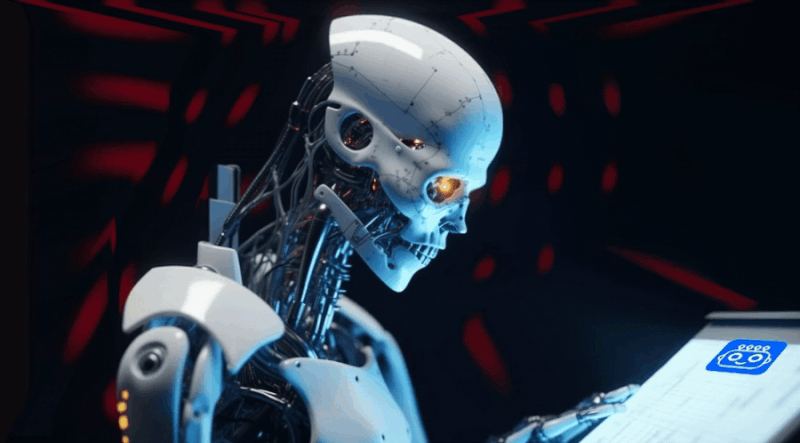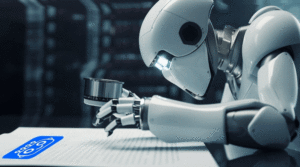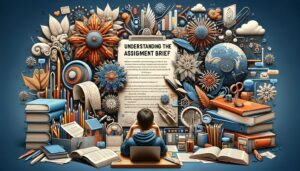With artificial intelligence (AI) tech booming, it’s got a lot of people all scratching their heads, wondering, “Can AI writing be detected?”
As AI gets sneakier, penning text that’s eerily human-like, we’re gonna dive deep into the nitty-gritty of AI writing and hunt for clues that might give away its mechanical roots.
The AI universe is booming, folks. AI-made stuff, like ChatGPT and its pals, are popping up everywhere.

Try these new AI-powered tools:
- 5 Best AI Detectors To Unmask AI-Written Content With Accuracy
- 5 Best AI Writers To Boost Your Productivity And Content Quality.
- This "Secret AI Writer" Can Bypass AI Detection Like A Pro.
AI writing’s been roped in for everything from straightforward online chatbot chit-chat to brain-busting college assignments, and it’s even cropping up in mainstream media.
Sure, it can tidy up some of those dull jobs, but can we sniff it out? Now that’s a question we’re all glossing over. Maybe we’re skirting around it, but it’s quite the big, glaring issue in the corner, wouldn’t you say?
As schools are tinkering with the idea of weaving AI into their classrooms, the need to whip up solid detection methods is something that’s got to be taken seriously.
In this article, we’re gonna take a closer look at how these AI writers tick and get clued up on the different ways to spot any sneaky or harmful uses of AI writing.
Article At-A-Glance
-
- AI-generated content’s taking the media world by storm, but leaning too heavily on machine-made stuff has its downfalls, like missing out on human insight and possibly dealing with programming biases.
- AI writing tools are tapping into machine learning and sequence prediction to spin out text based on patterns they’ve picked up. But they don’t have a true grasp of the content they’re churning out.
- Sniffing out AI-made text is a bit of a toughie, and calls for tricks like spotting patterns and inconsistencies in writing style, using plagiarism detection software, picking apart language patterns and syntax, and roping in good old human assessment.
- It’s not a cakewalk trying to detect AI writing, what with the risks of false positives and negatives, the fast-changing face of AI tech making it trickier to tell apart human and machine-made content, and the ethical worries over AI’s sway on public opinion.
Table Of Contents
The Rise Of AI-Written Content
AI-created content’s been skyrocketing, and now you’ll spot it everywhere in media – from blog posts, product blurbs, and promotional stuff, to academic papers.
AI writing gizmos, like GPT-4, come with a nifty auto-fill feature that lets job hunters, marketers, and other pros whip up relevant content in a blink. Yep, you heard that right – a blink of an eye!
As flashy as it seems at first peek, there are some pretty clear downsides to banking solely on machine-made content.
Naysayers flag potential hiccups with AI-written copy, like missing the human touch on tricky topics or potential biases hiding in its programming.
Plus, techniques used by plagiarism-detecting software won’t always nab these texts because they often mimic human-written articles too closely over long stretches, making it hard to tell the two apart before spitting out results flagging them as similar sources, but not straight-up copied work.
The Nuts And Bolts Of AI Writing Tools
AI writing tools, sometimes called language models, are a clever combo of machine learning and a slice of artificial intelligence.
These tools get schooled on a ton of text data, soaking up language patterns, sentence structures, and common phrases from a broad mix of sources.
Some top-notch tools, like OpenAI’s GPT-4, rely on a technique called ‘transformer’ neural networks.
At the heart of these tools is a thing called “sequence prediction”. In a nutshell, they guess what’s up next in a sequence, based on what’s come before.
In language, that means guessing the next word, given the previous words in a sentence. So, when you chuck a prompt at an AI writing tool, it uses the patterns it’s learned to generate a continuation that fits the context.
Here’s an example. Kick off a sentence with “The weather today is …”, and the tool might finish it off as “… sunny and warm.”
The prowess of these tools can vary a lot. Some can cook up simple phrases or sentences, while others can hammer out whole essays or even books. And if that’s not crazy enough, some can even pen songs.
The prowess of these tools can vary a lot. Some can cook up simple phrases or sentences, while others can hammer out whole essays or even books. And if that’s not crazy enough, some can even pen songs.
However, all these tools are banking on patterns they’ve learned and don’t truly “get” the text they’re creating. They’re making educated stabs in the dark based on what they’ve seen in their training data.
Can AI Writing Be Detected?
Unmasking AI-written content has become a hot topic lately, hence the push for software and tools to help spot this type of writing.
AI writing tools spit out text by using fancy algorithms and statistical models that pull off natural language processing tricks.
To tell AI-written text from human-made stuff, a mix of techniques comes into play. Plagiarism detectors can flag repeated words or twisted phrases while picking apart language patterns and syntax for oddities can help researchers figure out if a piece is computer-made or human-crafted.
Plagiarism detectors also keep tabs on word count and how many times keywords pop up. For example, if you’ve penned a thousand-word essay using a keyword ten times, the software can sniff out another thousand-word piece with the exact same keyword count.
So, even if you haven’t copied any content, you might still get flagged because your piece resembles another that uses the same number of keywords and has the same word count.
However, plagiarism detectors can only sniff out if your content is ripped off, not if it’s AI-made.
That’s why the human touch still counts big time when it comes to figuring out if the text was whipped up by AI tech. We, humans, might catch the oddities that algorithms might overlook. So, it could be wise to have a trained eye give the final thumbs-up on an article’s authenticity.
To cut down on false alarms during this process, the latest strides in machine learning are now getting meshed up with plagiarism detectors.
Detecting AI-Generated Text
To spot some crafty AI that’s been churning out text, you gotta play detective. Search for oddball patterns or things that just don’t add up in the writing style.
Get some help from tech with plagiarism detectors and dive deep into the nitty-gritty of language patterns and syntax.
And don’t forget, nothing beats a good old-fashioned human check.
Spotting Patterns And Inconsistencies In Writing Style
One surefire way to tell if a chunk of text is AI-made or not is by hunting for patterns and inconsistencies in the writing style.
By eyeballing the tone, flow, and word repetition, researchers have tried to sniff out which texts were cooked up by an AI system.
Some telltale signs often seen in AI-spun pieces include strange phrasing or vague topics, limited understanding of certain concepts, and lack of variety between different sentence structures.
Getting clued up on these patterns and inconsistencies can help us tell apart AI from human chatter more accurately.
For example, originality-detecting tech like GPTZero will scan articles for phrases that might hint at plagiarism or potential copyright breaches. Similarly, Originality.ai checks if stuff like sentence structure, grammar goof-ups, autocorrect errors, and so on match those usually seen in machine-written bits.
By doing this, both software platforms can flag potentially AI-authored content with a decent level of accuracy compared to the standards for human writing.
Cracking The Code With Pattern Recognition
Pattern recognition is a nifty method for sniffing out AI-generated text. It involves hunting for patterns and inconsistencies in writing style.
It’s useful for spotting specific phrases or words that might hint at AI tool use, like recurring character strings or word repetition.
By dissecting these patterns and comparing them to known examples of AI-generated content, you can figure out machine-made writing with a good level of accuracy.
By dissecting these patterns and comparing them to known examples of AI-generated content, you can figure out machine-made writing with a good level of accuracy.
Tools like ChatGPT are primed to spot patterns linked with machine intelligence by studying language, syntax, phrasing, dialogue structure, and other features in written text.
For example, they might keep an eye out for repeated sentences or catch common gaffes made by software programs like bungled verb conjugations. Other tools might even scan media sources, including images and audio recordings, to look for signs of manipulation techniques linked to deep fakes.
Also, certain types of text might get flagged if the results don’t live up to the standards expected of human writing.
Pattern recognition has been a winner in the past for detecting AI-scribbled articles from news sites and niche areas like medical journals, where jargon can quickly reveal suspicious quirks in language use that suggest a computer might have had a hand in writing the text.
Generally speaking, though, keep in mind that pattern detection on its own can’t guarantee an accurate verdict – human judgment will often still need to step in to confirm a suspected case before any conclusions are drawn.
Turning To Plagiarism Detection Software
Plagiarism detection software can be a handy ally for unmasking AI-generated text. These programs use everything from smart algorithms and pattern recognition techniques to natural language processing to identify features that can flag a text as AI or human-made.
Instead of just hunting for copied phrases and sentences, these programs study patterns within the text to figure out its origin.
By studying the words used, their frequency, the syntax structures used, and other language markers unique to humans or AIs — depending on what type of writing they’re looking for — these tools question if an essay “sounds” like it was penned by a human or machine.
Plus, things like citations, the flow of ideas across paragraphs, and meticulously crafted sentence structure can all give hints as to whether something’s been dreamt up by a human mind or churned out by artificial intelligence.
Getting Into The Nitty-Gritty Of Language Patterns And Syntax
Scoping out language patterns and syntax is vital when trying to sniff out AI writing. Sentence structure, word choice, and other linguistic bits and bobs can help us identify patterns that scream “Hey, a machine wrote this!”
For instance, texts whipped up by machines might include odd word pairings or phrasing that just doesn’t gel with how we usually chat or converse.
Likewise, the structure of sentences spun by an AI could come across as repetitive and might be peppered with ellipses or unfinished phrases, thanks to the AI’s somewhat shaky grasp of our grammar rules.
But, let’s be real, this method has its own hiccups. It all boils down to how brainy the underlying algorithm is behind a piece of text generated using artificial intelligence. There might not always be standout syntactic features for us to latch onto.
Even though natural language processing is getting better and better, machines are still a bit clunky when it comes to concocting something that could pass for a piece penned by a human – not unless they’re given extra training data that’s been specifically tweaked to mimic human-style writing.
Humans To The Rescue
AI writing detection tools are ace for getting to grips with and keeping tabs on AI-generated content. But let’s not forget that AI software isn’t flawless – there are limits to what automated systems can pull off.
That’s why human evaluation is crucial in accurately figuring out whether a piece of text is the handiwork of AI algorithms or a human writer.
One of the biggest headaches with spotting AI-generated text is sniffing out patterns and inconsistencies in writing style.
One of the biggest headaches with spotting AI-generated text is sniffing out patterns and inconsistencies in writing style. Here’s where humans have the upper hand because we’ve got more experience in catching subtle hints that might slip past computers.
Sure, plagiarism detectors can swiftly spot similarities between texts, but only a trained eye will be able to pinpoint deeper-level features like stylistic choices such as diction and word choice, which usually don’t pop up in automated analysis results.
Plus, humans are often better at spotting boo-boos or typos than computers – another telltale sign of computer-generated content – paving the way for more accurate detection overall.
Having a detailed understanding of written language also arms humans with the know-how to figure out why certain computational methods hit a brick wall – this feedback is key for polishing up existing tech or dreaming up new ones should a curveball come our way when we’re relying solely on programmatic tools.
The Hurdles And Headaches In Unmasking AI Writing
Despite leaps and bounds in AI writing detection tools, there are still a few thorny issues that need our attention.
These challenges include false positives and negatives in identifying AI-generated text, the constant evolution of AI tech designed to throw detectors off the scent, and ethical headaches over the potential sway of AI-written content on public opinion.
Beware Of False Positives And Negatives
AI writing detection systems work by nosing around language patterns in text and flagging certain words and phrases that look like they’ve been cranked out by a machine. But remember, they’re algorithm-based, so hiccups can and do happen.
This can give businesses the jitters, and many have decided to sidestep AI writers if there’s a hint of dodgy accuracy in detecting AI writing.
For folks creating content online, a wrong call could put a dent in their brand’s credibility. Not what you want on your plate, right?
What’s more, getting the detection wrong could unfairly point fingers at human authors, leading to a whole new level of legal nightmares.
So, it’s high time we plug any existing loopholes and dig out better solutions, making this tech a safer bet for businesses keen on using it responsibly.
AI Tech’s Evolution
As AI tech keeps pushing the boundaries, the line between human-produced and machine-cranked content can get seriously blurry.
AI-written text might have nuances that are tough for us humans to spot, leaving us scratching our heads over whether the content is AI-spun or human-penned.
And as artificial intelligence gets slicker, particularly in natural language processing (NLP), we might see machine-written content that’s pretty much a doppelganger for human prose.
And as artificial intelligence gets slicker, particularly in natural language processing (NLP), we might see machine-written content that’s pretty much a doppelganger for human prose.
Now, that throws up some serious questions about ethics and transparency. This smoke-and-mirrors approach could be used to sway public opinion, through everything from social media to academic papers. And if we can’t detect it, people could be fooled into thinking certain content is from a trustworthy source, not a cleverly disguised machine.
The Growing Power Of AI In Shaping What We Think
AI tech is making an increasingly big splash online, shifting our view of what’s real and what’s not. Given the leaps and bounds made in machine learning and natural language processing (NLP), AI can now spin out content that could easily pass as human-penned.
This doesn’t just change how we navigate the online world but also how public opinion is molded by AI-spun content.
Future Developments In AI Writing Detection
We need to keep forging ahead with new tech, like machine learning and AI-powered programs, to up our game in sniffing out AI writing.
How Machine Learning Is Getting Better
Machine learning, a hot topic in AI research, is seriously upping the ante in the battle to detect AI writing.
It’s proving its worth in separating human-penned content from computer-crafted text by examining patterns and language use.
Techniques like pattern recognition algorithms and plagiarism-hunting software have taken a quantum leap in recent years, thanks to the rapid evolution of machine learning tech.
Machine learning can zero in on the nitty-gritty differences between similar-looking documents and flag up things that seem off-kilter – stuff you’d usually miss using more old-school approaches.
Training data plays a pivotal role in hunting down AI writing. It helps neural networks learn from their blunders and label new inputs correctly as either AI-concocted or human-crafted.
Merging AI Writing Detection And Plagiarism Scanners
Pairing up AI writing detection software with plagiarism checkers forms a potent combo to discern whether a document is a brainchild of an AI.
Plagiarism detectors are ace at pinpointing text that’s been copied verbatim from elsewhere, but they’re not as savvy at detecting when words have been jumbled around or tweaked to give an illusion of originality.
By throwing AI writing tools into the mix, we can amp up our chances of flagging suspicious content.
Machine learning models can do a superior job of spotting minute discrepancies in sentence construction and grammar that may suggest the text was cooked up by an AI tool rather than being a product of human typing prowess.
Services like Turnitin employ a slew of different techniques to identify the idiosyncrasies that naturally occur in human communication, like typos or distinctive sentence patterns, that don’t usually feature in machine-generated text.
Following this, machine learning models can do a superior job of spotting minute discrepancies in sentence construction and grammar that may suggest the text was cooked up by an AI tool rather than being a product of human typing prowess.
Linking these two services also enables detailed reports showing similarities between two pieces of text when compared side by side, making it easier to spot close resemblances, even when one may have been produced by automation while the other was manually penned.
Training Programs For Human Evaluators
As AI writing tools get increasingly sophisticated and accessible, it’s vital to be able to distinguish authentic human prose from machine-spun content. That’s where the need for training programs for human evaluators comes in.
This means we need to get human checkers trained to tell the difference between human and machine content. They need to know what to look for to spot patterns in how something’s written that could suggest it’s been created by an AI, such as sentences that aren’t quite right or weird word choices that you wouldn’t usually see people use.
This could involve looking at how language is used, the structure of sentences, results from plagiarism detection software, or other parts of the text that might make you think it’s been created by a computer instead of being the natural product of someone’s thoughts.
Right now, loads of organizations are pushing for being clear and upfront when it comes to content created by AI. So, we must have training programs in place so human checkers can properly look at any bit of online content and work out whether it’s been created without any help from AI tech.
Otherwise, you run the risk of people being led down the garden path by false positives if they can’t rely on dependable sources for trustworthy info.
AI Detection Remains A Work In Progress
As we see more and more writing being churned out by AI, we’re going to need detection tools that can confidently tell whether a bit of text has been penned by a person or a machine.
Right now, our methods for spotting AI-generated content still have some kinks to iron out and need some more development and testing for accuracy.
Right now, our methods for spotting AI-generated content still have some kinks to iron out and need some more development and testing for accuracy.
Tools like Turnitin are one possible answer to the problem of AI detection, while another tool on the scene from Harvard, known as GLTR, is also proving its worth in the quest to figure out if a text has been whipped up by an AI program.
The need to be able to pick out passages of text written by AI is a big deal. It means we can all become savvier readers, better able to judge how genuine the content we’re seeing every day really is.
Meet our resident tech wizard, Steve the AI Guy. Now, before you get any wild ideas, let’s clear up one thing – he’s 100% human! I mean, he’s got the work history to prove it. He spent a decade diving into the deep end of the tech industry doing business intelligence work, splashing around with two of the world’s largest business consulting companies, Deloitte and Ernst & Young. Learn More









